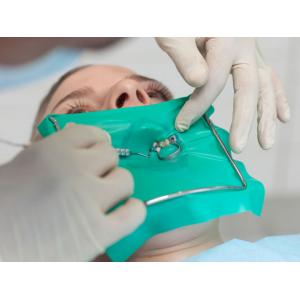

Add to Cart
Rubber Dam Sheets Disposable Dental Rubber Dam Cheek Retractor Material
Disposable dental rubber dam cheek retractors are typically made from soft, flexible materials that are safe for use in the oral cavity. Common materials include medical-grade plastics or elastomers that meet health and safety standards.
1. Plastics:
- Polypropylene (PP): PP is a commonly used thermoplastic in
medical applications. It is known for its flexibility, chemical
resistance, and biocompatibility.
- Polyethylene (PE): PE is another type of thermoplastic that is
often used in medical devices. It is lightweight, durable, and has
good chemical resistance.
2. Elastomers:
- Latex-Free Materials: Due to the potential for latex allergies,
many disposable dental products, including cheek retractors, are
made from latex-free materials.
- Silicone: Silicone is a flexible and biocompatible material that
is commonly used in medical and dental devices. It is resistant to
heat and chemicals, making it suitable for dental applications.
3. Biocompatibility:
- Medical-Grade: The materials used in disposable dental products
are typically medical-grade, ensuring they meet safety and
biocompatibility standards for use in the oral cavity.
4. Design and Flexibility:
- Flexibility: The material needs to be flexible enough to provide
comfort to the patient and allow for easy insertion and removal.
- Smooth Surface: The surface of the cheek retractor should be
smooth to avoid any discomfort or irritation to the patient's oral
tissues.
5. Single-Use Design:
- Hygiene: Disposable cheek retractors are designed for single use
to maintain hygiene and reduce the risk of cross-contamination
between patients.
| Name | Rubber Dam Sheets |
| Size | 6” x 6”(152mm x 152mm) |
| Material | Rubber |
| Color | Blue,green, white |
| Powder | Powder-free |
| flavor | Mint flavor |
What is the primary purpose of a rubber dam?
The primary purpose of a rubber dam is to create a dry and isolated working field, preventing saliva, blood, and other contaminants from interfering with the dental procedure.
Why is the dentist using a rubber sheet?
1. Isolation of the Treatment Area:
- The rubber dam isolates the specific tooth or teeth being
treated, creating a dry and clean field. This isolation prevents
saliva, blood, and other oral fluids from contaminating the tooth
during the procedure.
2. Moisture Control:
- Maintaining a dry environment is crucial for the success of many
dental procedures, such as restorations (fillings), crown
placements, and especially root canal treatments. Moisture control
ensures that dental materials adhere properly and that the dentist
can work with precision.
3. Infection Control:
- The rubber dam provides a barrier against bacteria present in
saliva. This is particularly important during procedures involving
dental pulp, such as root canal therapy, to minimize the risk of
infection.
4. Enhanced Visibility:
- By isolating the treatment area and keeping it dry, the rubber
dam improves visibility for the dentist. This allows for more
accurate and efficient dental work, leading to better treatment
outcomes.
5. Patient Safety:
- The rubber dam helps prevent accidental ingestion or aspiration
of dental materials, instruments, or debris by the patient,
enhancing overall patient safety during the procedure.
6. Comfort for the Patient:
- While the initial placement of the rubber dam may feel unfamiliar
to patients, it generally helps in keeping the rest of the mouth
free from dental materials and instruments, contributing to a more
comfortable experience.
7. Efficiency:
- The use of a rubber dam can enhance the efficiency of dental
procedures by providing a controlled and dry environment, allowing
the dentist to work more effectively.
8. Prevention of Contamination:
- The rubber dam minimizes the risk of contamination from airborne
particles or other external sources, ensuring a clean environment
for dental work.
9. Improved Infection Control:
- In addition to preventing contamination, the use of a rubber dam
contributes to overall infection control within the dental office
by reducing the spread of oral bacteria.
Can I talk with the rubber dam in place?
While talking might be challenging, you can try making basic sounds or humming to indicate your needs. Dental professionals are accustomed to working with patients in various situations.
In some cases, dental offices may provide a small whiteboard or notepad for written communication. You can write down any concerns or questions you may have.
